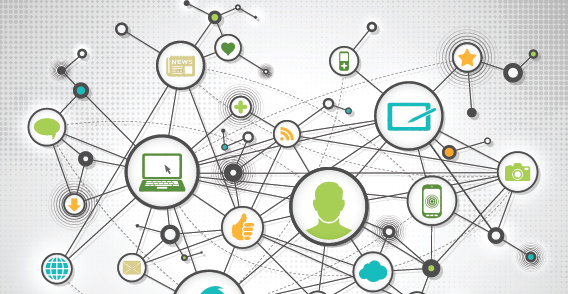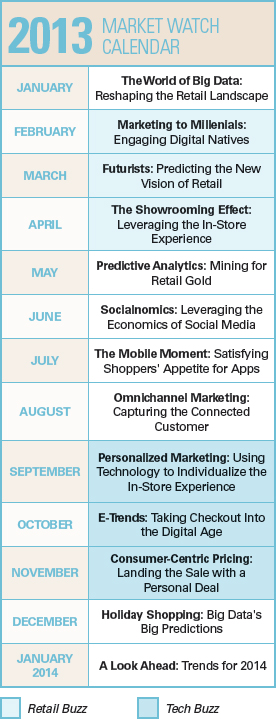
Welcome to 2013—the year in which retailers and manufacturers work together to leverage the wealth of available data to drive sales and achieve goals that were unimaginable just 10 years ago. Today our industry is in the midst of a knowledge revolution where we face the choice of embracing Big Data to stay relevant, competitive and profitable or continuing with “business as usual” and falling by the wayside. Put simply, Big Data is the foundation for the future of retail sales.
But do you really understand what Big Data is and why it’s so important? If not, you’re not alone. In this article, we’ll define Big Data and explain who’s using it, how it impacts sales and how it can be used to reshape your business on a larger scale. We’ll also look at some of the challenges involved with transitioning an organization to a Big Data-driven model.
First, the what of Big Data: though still evolving, Big Data is loosely defined as the explosion of information now being collected from shopping and browsing (brick-and-mortar and online), social media, mobile devices, census surveys and numerous other sources. According to Inc. and the International Data Corporation (IDC), by 2011 there was enough data in the world to fill the memory of 86 billion iPads. And per the IDC, that amount now doubles every 18 months.
But the buzz about Big Data isn’t simply about the quantity of information collected; it’s about the power that information holds. With the help of cutting-edge technology, retailers and CPGs can use this data to discover patterns and insights that enable them to drive revenue growth and increase operational and promotional efficiencies. The McKinsey Global Institute estimates that retailers who use Big Data effectively have the potential to increase operating margins by more than 60 percent, directly cannibalizing sales of their competitors.
“Data mining is becoming a key element in all major aspects of marketing communications,” says Eric Williams, Retired Executive Vice President, CIO and Chief Privacy Officer of Catalina Marketing. To be competitive, retailers “have to be smart enough to accommodate… multiple data sources to intelligently determine which offers and which type of media should be utilized to [optimize sales].”
Industry leaders reaping the benefits of Big Data include Amazon.com, Best Buy, Wal-Mart and Target. For example, by analyzing baby registry and purchase data, Target created models that accurately predict when a woman is pregnant—even what trimester she is in. They can then send targeted marketing materials to entice her to purchase timely pregnancy and baby related products. Many experts credit this type of Big Data usage with Target’s impressive revenue increases, which rose from $44 billion in 2002 to $67 billion in 2010 (the same period Target began aggressively utilizing Big Data).

“It isn’t just top retailers who are positioned to reap the benefits of Big Data,” says Giovanni DeMeo, Vice President Global Marketing for Interactions. “As more companies are embracing Big Data, and technologies are improving, Interactions and Daymon Worldwide are uniquely positioned to provide retailers and CPGs with programs that offer critical insight and value that they cannot achieve on their own. Interactions is currently testing a pilot program with one retailer to aggregate and analyze numerous data sources for the purposes of optimizing the data for the benefit of both the retailer and the CPGs. In addition, we’re in discussions with two other retailers to provide a similar program.”
With the right tools in place, retailers and CPGs can use Big Data to explore the full impact of consumer behavior, both in-store and beyond. They can more accurately communicate with shoppers and develop products and messaging targeted directly to individual consumers. Retailers can also be more efficient with inventory, eliminate out of stocks and even accurately predict future store sizes. As Big Data continues to grow, the possibilities seem limitless.
The transition to a Big Data-driven business model is not without challenges. It is a cultural change requiring leaders to accept that the days of the HiPPO (highest paid person’s opinion) are ending. This is not to say that Big Data replaces the need for visionaries and human insight; but if Big Data is embraced, trust in the data is critical. It also requires companies to commit resources to uniquely qualified Data Scientists whose exclusive responsibility it is to monetize the data. John Lucker, a principal with Deloitte, says that “leading service and [retail] companies are now moving to appoint CDOs (chief data officers), within their organizations…separating aggregation and management of data (IT) from strategic analysis and utilization of the data.”
“The transformation to a culture of Big Data is no small feat,” said Ju-kay Kwek, Big Data Strategy Product Manager for Google Inc., during a conversation with Giovanni DeMeo regarding a new partnership between Google and Interactions. “[However, it’s one that] must be done. If you’re not discussing Big Data at this point… [know that you have] already fallen behind [your competitors].”
So is Big Data tomorrow’s next big thing? Forget tomorrow! Big Data is here now and has been for quite some time. It’s today’s retail sales Holy Grail in a world where consumer information is king.

